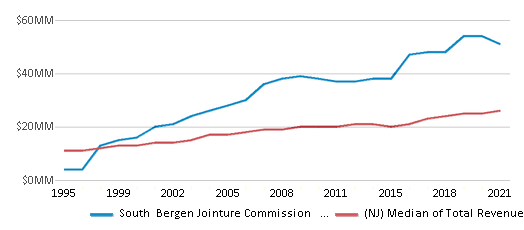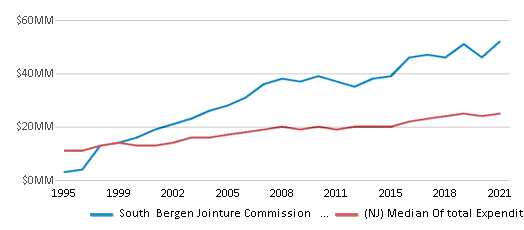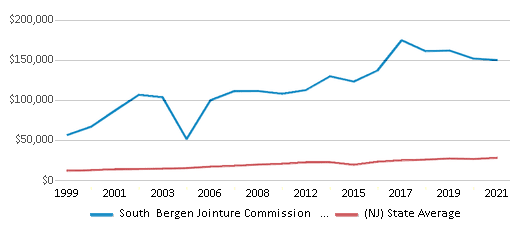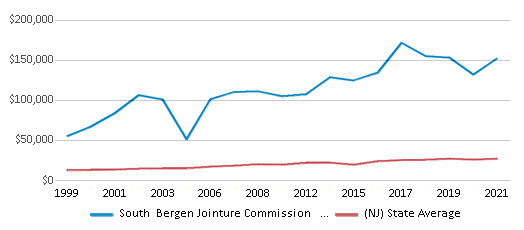Top Rankings
South Bergen Jointure Commission School District ranks among the top 20% of public school district in New Jersey for:
Category
Attribute
Student Attention
Lowest student:teacher ratio (Top 1%)
For the 2025 school year, there are 2 public middle schools serving 133 students in South Bergen Jointure Commission School District.
Public Middle Schools in South Bergen Jointure Commission School District have a diversity score of 0.67, which is less than the New Jersey public middle school average of 0.72.
Minority enrollment is 59% of the student body (majority Hispanic), which is less than the New Jersey public middle school average of 68% (majority Hispanic).
Overview
This School District
This State (NJ)
# Schools
3 Schools
835 Schools
# Students
325 Students
458,046 Students
# Teachers
57 Teachers
39,885 Teachers
Student : Teacher Ratio
6:1
6:1
District Rank
The school district's graduation rate of 50% has stayed relatively flat over five school years.
Graduation Rate
(10-11)<50%
86%
Students by Ethnicity:
Diversity Score
0.63
0.72
# American Indian Students
n/a
913 Students
% American Indian Students
n/a
n/a
# Asian Students
15 Students
39,872 Students
% Asian Students
5%
9%
# Hispanic Students
136 Students
173,877 Students
% Hispanic Students
42%
38%
# Black Students
28 Students
84,536 Students
% Black Students
9%
18%
# White Students
141 Students
145,711 Students
% White Students
43%
32%
# Hawaiian Students
2 Students
858 Students
% Hawaiian Students
n/a
n/a
# Two or more races Students
3 Students
12,134 Students
% of Two or more races Students
1%
3%
Students by Grade:
# Students in PK Grade:
72
12,448
# Students in K Grade:
23
19,022
# Students in 1st Grade:
25
19,268
# Students in 2nd Grade:
30
19,849
# Students in 3rd Grade:
20
20,625
# Students in 4th Grade:
23
22,766
# Students in 5th Grade:
19
30,973
# Students in 6th Grade:
24
79,058
# Students in 7th Grade:
15
100,830
# Students in 8th Grade:
11
101,895
# Students in 9th Grade:
6
8,812
# Students in 10th Grade:
14
7,480
# Students in 11th Grade:
13
7,369
# Students in 12th Grade:
30
7,529
# Ungraded Students:
-
122
District Revenue and Spending
The revenue/student of $157,172 is higher than the state median of $26,931. The school district revenue/student has stayed relatively flat over four school years.
The school district's spending/student of $159,366 is higher than the state median of $25,828. The school district spending/student has stayed relatively flat over four school years.
Total Revenue
$51 MM
$36,642 MM

Spending
$52 MM
$35,142 MM

Revenue / Student
$157,172
$26,931

Spending / Student
$159,366
$25,828

Best South Bergen Jointure Commission School District Public Middle Schools (2025)
School
(Math and Reading Proficiency)
(Math and Reading Proficiency)
Location
Grades
Students
Rank: n/an/a
Lodi Middle School High School
Special Education School
123 Union St
Lodi, NJ 07644
(973) 249-0995
Lodi, NJ 07644
(973) 249-0995
Grades: 6-12
| 91 students
Rank: n/an/a
Moonachie Campus
Special Education School
Robert L. Craig School, 20 Wes
Lodi, NJ 07644
(973) 249-0995
Lodi, NJ 07644
(973) 249-0995
Grades: PK-8
| 42 students
Recent Articles

Sexual Harassment at Age 6: The Tale of a First Grade Suspension
A six-year old in Aurora, Colorado, was suspended after singing an LMFAO song to a little girl in his class and reportedly “shaking his booty.” We look at the case and the sexual harassment problem in public schools today.

How Scaffolding Could Change the Way Your Child Learns
This article explores the concept of instructional scaffolding, a teaching method that enhances learning by breaking down complex tasks into manageable parts. It highlights how scaffolding supports students in developing critical thinking skills and becoming more independent learners. The article discusses the benefits of scaffolding, including improved engagement and reduced anxiety, and provides strategies for its implementation across various educational levels.

February 05, 2025
Understanding the U.S. Department of Education: Structure, Impact, and EvolutionWe explore how the Department of Education shapes American education, from its cabinet-level leadership to its impact on millions of students, written for general audiences seeking clarity on this vital institution.





